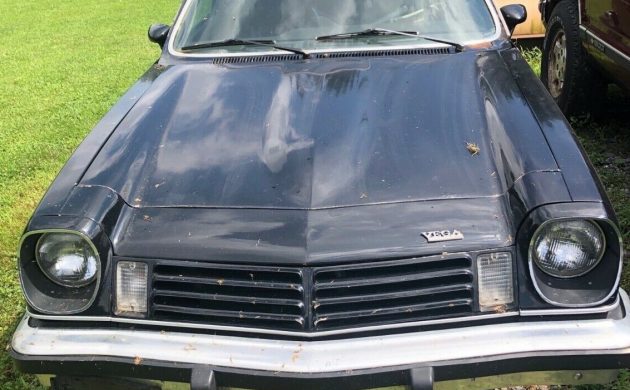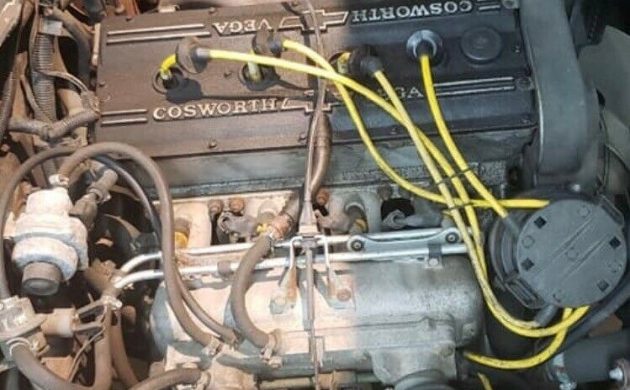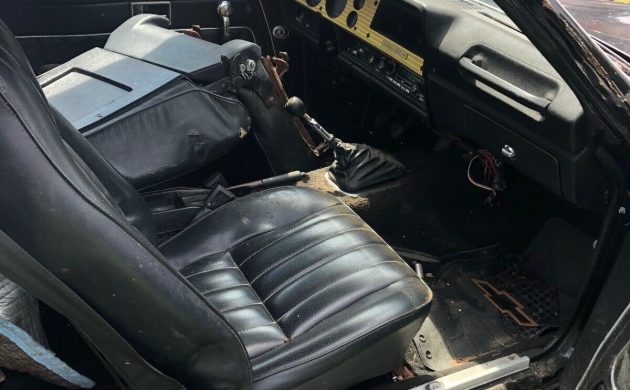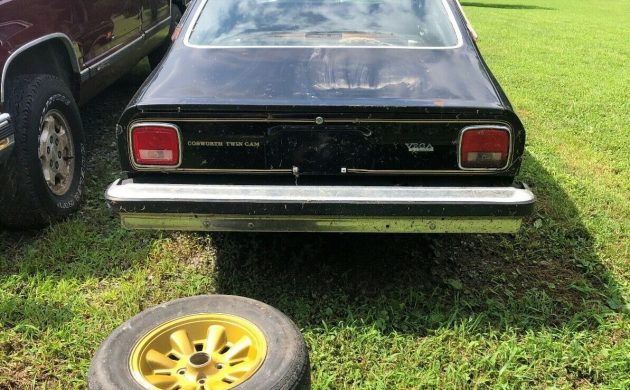The Chevy Vega doesn’t have a big following with collectors, but the limited-edition Cosworth Vega does draw attention. That’s because of the all-aluminum inline-4 that was developed by Chevy but modified with a DOHC cylinder head designed by the British company Cosworth Engineering. The car only saw 3,500 or so copies made over two years, including the seller’s 1975 model located in Lansdale, Pennsylvania. It’s a non-running project with some missing pieces but is being offered with no reserve here on eBay. So, someone will get the car, regardless of how the bidding goes, currently at $1,250.
Chevrolet had high hopes for the Vega when it was conceived as their first sub-compact in the late 1960s. But not long after its 1971 debut, the car began to develop a bad reputation for poor construction quality and mechanical issues. If it had not been for the energy crisis in 1973 that drove buyers to fuel-efficient cars, the Vega may not have lasted. Toward the end of the automobile’s run, Chevrolet formed a partnership with Cosworth and they came up with a performance-oriented edition to generate some spark. It didn’t help and the Vega finally retired in 1977.
The Cosworth-modified engine enabled the powerplant to generate 112 hp. 5,000 of the engines were built to go into 3,508 cars (does that mean the other 1,492 motors were spare?). 2,061 of the Cosworth Vega’s were built for the 1975 model year and the rest for 1976. The MRSP for the car was nearly twice that of the basic Chevy Vega and just $900 cheaper than a Corvette. Which likely meant that buyers weren’t incented to try an “improved” Vega when a ‘Vette could be had for a few hundred bucks more. All first-year Cosworth Vega’s were finished in black acrylic lacquer with gold “Cosworth Twin Cam” lettering on the front fenders and rear cove panel and gold pinstriping on the hood bulge, body sides, wheel openings, and rear cove.
This Cosworth Vega looks to have been sitting outside for a while. There is some visible surface rust, but since most of the photos are of just dark portions of the car, we’re not sure that the problem hasn’t gone any deeper. But with the Vega’s history in that area, close inspection is always suggested. The interior may not be complete with the steering column missing for certain. The driver’s seat is not bolted in, and the upholstery is said to be torn in places.
To get the engine running again, it will require a new water pump and gas tank (both are missing; sounds like this was already turning into a parts car). But beyond the MIA pieces, it’s not known what internal issues the drivetrain may have. This includes the 4-speed manual transmission. The seller has some extra parts for the car including a pair of Cosworth Vega wheels. The Cosworth Vega has greater resale value potential than the standard Vega: $18,000 vs. $3,000 with both numbers on the high end. Would you try to restore this car or use it as a donor for another Cosworth Vega project?







I know a guy who had one of every color they made, including two black ones. One stock and the other turbocharged. It actually ran pretty well until he went nuts with the boost and blew the motor up. I made his day telling him how when I worked at a Chevy dealer we were making room in our tool room for special tools and threw away unopened boxes of Cosworth unique tools. Dumb thing now but we never serviced one in all the time I was there nor did we sell one.
The Cosworth engine was actually this cars biggest downfall. To get only 112 HP combined with terrible fuel economy and even worse reliability after such a huge design and engineering investment was a downright embarrassment.
Please copy and paste this – https://en.wikipedia.org/wiki/Chevrolet_Cosworth_Vega
From a performance perspective, considering the times, the engine actually did pretty good. The car reviews and comparison tests are very favorable as well. Some historical context is needed. It also appears the budget and engineering resources to bring this engine to market was not great.
This same engine was raced in period in European road racing (Chevron used it in their small displacement sports racing cars) and saw north of 300hp on the dyno (not for very long, mind you!)
The engine wasn’t the problem. You could make plenty of power with it. Emissions were the problem, and dialing back the timing to stunt the car’s performance (among other measures taken) killed performance. The muffler alone sucked 20-22hp out of it, which is a shame, as it came with a really sweet stainless steel header from the factory…..
You can make 200hp all day long with this motor. Longevity isn’t a problem. We have a long-raced CWV in the shop (we own it now) and it has been beat on for many, many years on western road tracks in Oregon and California.
Small bore dirt track racers have used this engine for decades (we actually have a spare Hilborn injection system for our motors, right off the dirt track!), as have Bonneville guys.
cheers,
BT
Chevy and GM entered the world of the 80s and beyond with a 16-valve, DOHC, fuel injected 4. It was pretty damn unique in 1975, but instead of building on it, we got another 18 years of the Iron Duke and didn’t get another DOHC four until the Quad 4 in 1987. It’s kind of similar to the GM turbocharging leading the way in the early 60s, but then stopping again until the late 70s. Or even the more recent EV1 of the 90s.
I actually own a white 8,900 mile (yes 89 HUNDRED) 5 speed. Honestly I love the little car. I have had a total of 4 of these (2 black 1 maroon and the white one) and they certainly are not rocket ships but they are a cool example of early electronic injection. This one for sale has some serious rust in the exterior c pillars which is generally the beginning of the end for any vega. Too far gone for my taste but it could provide some really hard to find parts.
Complete turd of of a car.
Still love the Cosworth Vega, after all of these years-hoping the right person gets this car, even as a parts car. Hoping someone turns up who collects Baldwin-Motion Vegas…..
To each their own. Unless its a Porsche 550 Spyder (thus the cool factor is through the roof) owning a collector car with an anemic 110 hp doesn’t make any sense to me. What’s the attraction?
Q – Who spends $18,000 on a Cosworth Vega?
A- No one.
One sold for 48 Grand,,,
Crap car built by disgruntled hippies.
Peace and love, Jwaltb. Peace and love.
Just lipstick on a pig.
I’ve always admired the body style, especially the hatchback design. A nice little built 327 in this car would make it something to reckon with!
If you have never owned one you simply won’t understand them. Low production ( 2yrs only) numbered cars, 2.0L twin overhead cam fuel injected motor (all signed by it’s assembler at the infamous Tonawanda Plant) controlled by a CPU (located behind the glove box, ahead of it’s time for ’76 but very basic today), mine is a ’76 so it has galvanized body panels and a 5spd (unheard of in a domestic in ’76), factory header that was choked off by a anemic exhaust system with a power sucking cat. Put a decent exhaust system on it, do a little bit of head and valve work and you end up with a pretty wicked reliable fun little car that can really carve up the corners. Keep the V8 conversions for the 2.3L Vegas. Ignorance is bliss I guess in some cases.
Anyone notice if the steering column was there? Cant tell how much is missing from this car.
The stock Vega engine was not all-aluminum. The head was cast iron, and the different expansion rate of the iron head vs the aluminum block was part of the reason Vegas chewed up head gaskets.
By the time the Cosworth Vega engines were in production, had he blocks been modified from the original open deck free standing cylinder bores to closed deck blocks that supported the upper part of the cylinders? On the early Vega that were being modified, one effort went into machining a circular groove in the cylinder top so a gas filled Dykes sealing ring could be clamped in place to prevent the fretting movement between the two different expansion rates of the block and aluminum cylinders.